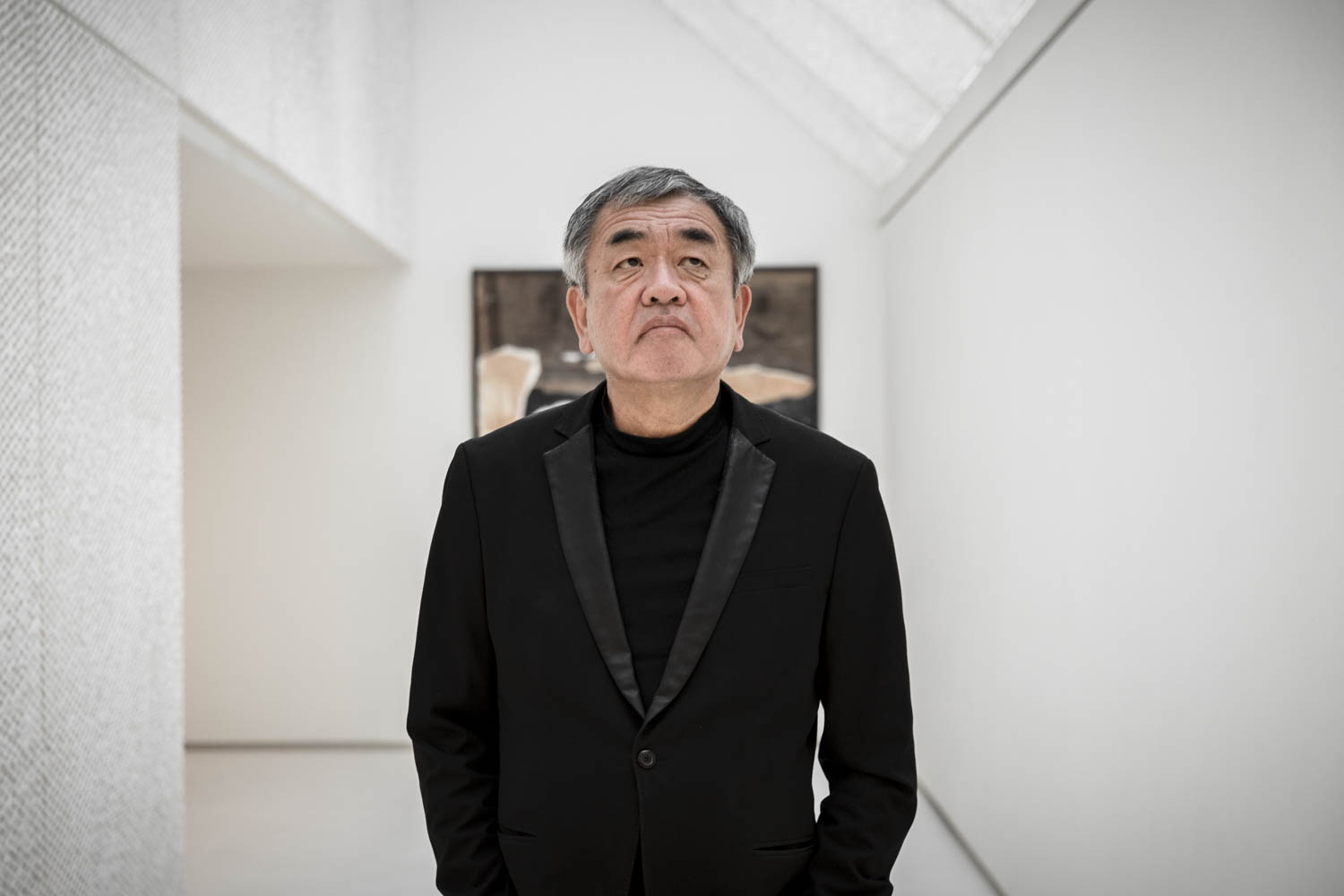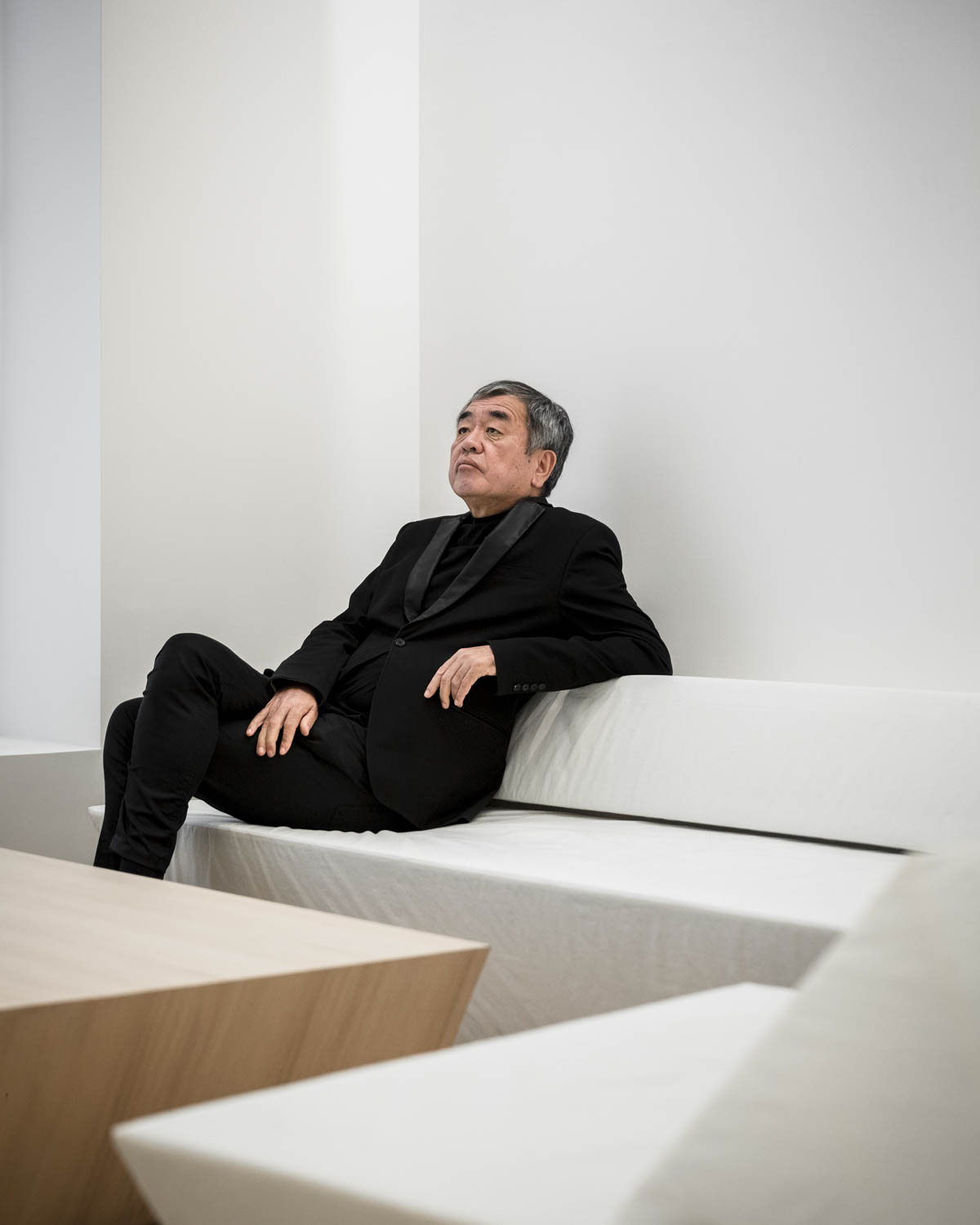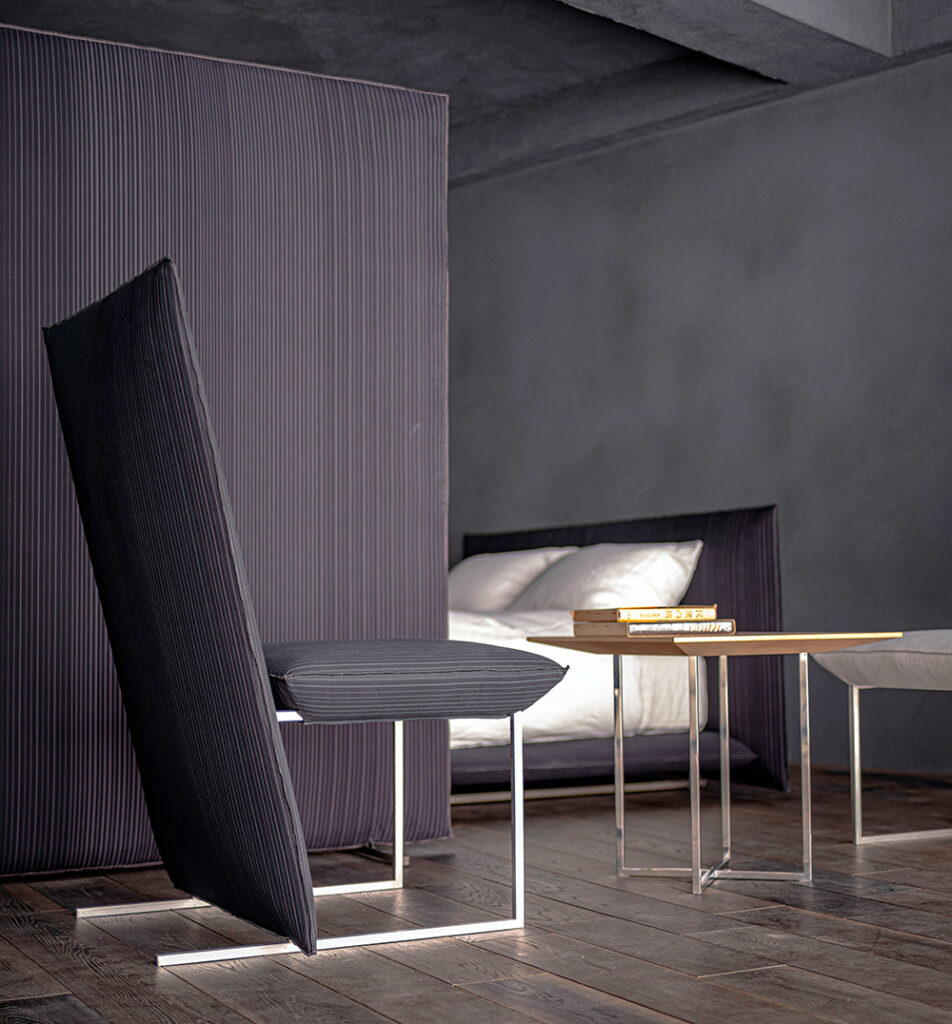
Architecture and furniture
— Normally, the design of the interior space and furniture is regarded as the work of product designers and interior designers. However, Kuma designs the interiors and furniture for all projects in order to maintain a consistent concept. In the furniture industry, none of architects released such a wide variety of the product collections. You are considering architecture on a large scale, while in the meantime, designing furniture on a small scale. Today, we would like to reveal Kuma’s idea from the aspect of the interior and furniture by going through the products we have developed for projects. The first collaborated project was the NC chair designed for Nezucafé at the Nezu Museum.
Kuma For the design of the Nezu Museum, I had an idea that the main part was the garden. It was surprising that such a garden still existed in the very center of Tokyo. So, the point was how to create the architecture that would appreciate the value of the garden. My intention was to make the building and furniture as light as a breeze, and I wanted to design the cafe where people could feel the breeze from the garden. The chair has a geometric form with gentle curves, which add a subtle softness. My idea was that people recognize the geometry but also feel the natural wind from the chair. As the result, the cafe in the center became the symbolic space in the museum. Although several museums have cafes, the cafe at the Nezu Museum is special and symbolizes the spirit of the museum. The original house of Mr. Nezu used to be located in the exact same place. For instance, the stove, which used to be in Mr. Nezu’s house, is still preserved inside the cafe. I believe such a story makes the cafe a symbol of the whole museum.
— When it comes to furniture design, the product development involves the consideration of concepts, materials, or the way how it will be used. Starting the concept of the chair from the garden, Kuma tried to scale it down from building to furniture. Furniture brands and product designers cannot normally have such a way of thinking. The design of the chair needed to be thin and light to highlight the garden. The wooden legs gradually become thin towards the end with the inner side shaved to look thinner. We tried to give a lighter impression than the actual thickness. Later, we developed the KA sofa for a project in China, whose structure was a diagonal surface. The interior space in Kuma’s architecture has a diagonal element. Do you think that connects to a Japanese teahouse as you mentioned before?
Kuma When it comes to minimizing the measurement of the space, a slight diagonal changes the minimal space into a spacious look. I think the Japanese teahouse has been chasing that kind of magic of the diagonal. There was a time when Europeans paid attention to the magic of the diagonal. From the 1960s, people started to become bored with the straight lines of Modernism. In France, coming into the era of the diagonal called the “oblique,” the Europeans did not reach the point of the diagonal world of the Japanese teahouse where a subtle diagonal change the entire look. In this sense, I am very proud of it as Japanese. In a minimal design, furniture with a slight diagonal element can provide a light presence or a safe feeling. Those subtle adjustments will be the crucial part of the design. That part is the same as the Japanese teahouse.
— In contrast to the same size sofa, Kuma’s sofa has a spacious appearance rather a narrow impression. As the next project, a wooden stackable chair was developed for GC protho museum. In that building, wooden joints, and wooden panels with several variations of wood have been used. What was the starting point for this project?
Kuma Well, wooden architecture is usually made using joinery of 10 cm square wood. So, 6 cm squares are not on an architectural scale but more of a furniture scale. The whole building of GC is built on the basis of the idea of a furniture scale beyond the architectural scale. In such a space, I thought the furniture must have lighter design than 6 cm square joinery and offer comfort for bodies. We faced more difficult challenges.
— Yes, the thickness of the rear legs is only 4 cm. We tried out many prototypes.
Kuma Those challenges motivated us to work hard together, which resulted in the quality of this chair. If normal furniture is placed in that space of 6 cm square joinery, the furniture will look bold.
— There has never actually been such a light stackable chair made of wood. Such complicated tenons have not been used for normal chairs. This tenon connects each part to the bigger joint area, developed for this wooden sensitive stackable chair. This technique was made from the collaborated work with you. I think we designed an iconic chair, which is related to Japanese wooden architecture.
Kuma This tenon is very beautiful. It’s a pity that this is the invisible part. A few people can feel this effort from this chair. So, we made a chair only a few people would be able to understand.
— Later, Time & Style worked on many projects, including Starbucks Coffee at Dazaifutenmangu. You use natural materials, like bamboo and Japanese washi paper in the interior. Do you have any preferences for furniture materials? In a normal project, many people prefer maintenance-free fabrics, which protect against dirt and scratches. You choose fabrics, natural solid woods, and sliced veneers for chairs and sofas. Are there any similarities in terms of the materials selected for the furniture and building?
Kuma The choice of furniture is generally based on the ideas that people from the general affairs department tend to have. The job of that department is mainly maintenance, which is why materials are used that offer eternally stable colour. On the other hand, Japanese traditionally value the process of tools that change colour over time. We have the moral principle that the changing colour enhances the value. I also think that it’s time to bring those kinds of values into furniture. I think eternal non-changeable colour like the ideas from general affairs doesn’t sound like a living thing. Human beings age as do all creatures. In this sense, I hope in the future people will value more the furniture that becomes older naturally, which can also be attractive. A long time ago, when I designed the Tokyo University of Agriculture, the president of the university said, “Please use materials where the colour and texture change in the future.” I was so surprised. I am usually asked to use materials where the colour never changes; however, he is a scholar and mentioned, “In biology, non-changeable colour means a monster. That is creepy. Changing colour means materials close to human beings.” That was a revelation.
— Kuma’s architecture has multi-dimensional panels and louvers, which looks a lot like a living thing. When I visited Sunny Hills after its completion, I had an interest in the aging process of the wooden facades.
Kuma I try to design aging or the transition itself. Normally, building is designed by imagining the time of completion. Of course, I do plan that point, but I also imagine the buildings in five, ten, or even twenty years in the design process and consider the balance of colour for each time.
— Traditional Japanese wooden architecture, temples, and shrines are made of wood. Japanese people have a fundamental sense of beauty toward changes in the wood. We released products inspired by Japanese zabuton (square floor cushions) in 2013 and developed a GC chair with zabuton cushion seating first, and then the FU sofa and MA sofa later. Where does the idea for zabuton come from?
Kuma Normal sofas are made by a method that wraps the base box with fabric. At some point, conventional sofas have the volume that we don’t like to place in our architecture. The reason is because it looked unnatural compared to zabuton. From my childhood, I’ve had zabuton cushions that could support the entire body with its softness. I think zabuton has a sensitive yet kind presence. That was completely different than the conventional box type cushion, and I wanted to bring that idea into furniture. If we start to be particular about zabuton, we need to consider the hardness of the inner cushion and variations in the fabrics for each season. However, I felt that the most important part was the stitching on the edge. When people choose clothing, everyone pays attention to the stitches and sewing on the edge. So far, I don’t know why, but people focus more on the shape of the whole sofa, instead of the details of the edge and stitches. I felt there were possibilities for a different furniture world by paying attention to that point.
— Right, we searched four or five samples of stitches on the edge, the thickness of the line, and the width of the intervals. I felt that the sofa was clothing-like. Now, I can understand why you were so particular about the shape of the edge and sewing. As the last question, please tell me about the furniture you want to develop in the future and your idea about furniture in the future.
Kuma First, the low level of the zabuton looks attractive to me. I have a feeling that furniture will be close to zabuton. In contrast to beds, we have shikibuton (Japanese floor mattress.) However, it’s not easy to fold and put away. These days, some onsen spa resorts use a mattress that is of medium height between the bed and shikibuton. Europeans can naturally accept the concept. If I design furniture that is middle height with the element of zabuton that can be accepted internationally, it would be exciting. I think furniture should be understated in a space. The starring role in architecture is our bodies, landscape, and food. I believe we can send a strong message to the Western world of furniture.

– 建築に於けるインテリアや家具は、通常プロダクトデザイナーやインテリアデザイナーの仕事の範疇とされていますが、隈さんは全てのプロジェクトにおいて、インテリアと家具を建築と一貫したコンセプトのもと設計されていて、1人の建築家がこれほどの商品ラインナップを家具メーカーから発表することはこれまで家具業界ではなかったことです。建築という大きいスケールを扱いながら、同時に家具のような小さなスケールも一点一点デザインされていますよね。本日はこれまでのプロジェクトの中で開発してきたプロダクトを通し、インテリアや家具という側面から隈さんのお考えを御伺いできればと思います。最初に携わったプロジェクトが根津美術館のNezucaféの為にデザインしたNCチェアでした。
隈 研吾 根津美術館の時に考えたのは、庭が寧ろ主役な美術館だと思っていて、あれだけの庭が東京のど真ん中にあること自体が驚異的なことだし、そういう庭に対して建築が引き立てるにはどうしたらよいか考えました。家具も含めて、建築も家具も風が流れるような感じにして、庭に吹く風をカフェの中に居ても感じられるようにしてみたいと思ったんです。基本的には幾何学的なんだけれども、微妙にカーブが付いていたり、少しの柔らかさがあることによって、幾何学であるけれども、自然の風を感じられる椅子にしたいなと思いました。結果として根津美術館は、真ん中のカフェがすごく象徴的な存在になって、カフェのある美術館は色々ありますが、根津美術館のカフェは特別で、あの美術館の精神を象徴しています。あそこは実際根津さんの家が建っていた場所で、あの中に保存してある暖炉なんか、根津さんの家で使っていた暖炉がそのまんまあるわけだから、そういうストーリーがあるが故に、余計美術館全体を象徴する存在になっているんじゃないかなと思います。
– 通常、家具のデザインを考える時、コンセプトや素材、使われるシーンやなどを想定して、開発していきます。椅子のコンセプトが庭から出発して、建築、家具とスケールダウンしていくという発想は、家具メーカーやプロダクトデザイナーが考えても、なかなか辿り着かないと思います。庭を引き立てるために、薄く軽やかにする必要があったのですが、木脚は先端に向かって徐々に細くなっているだけでなく、内側にも角度とつけて、実際の太さよりも、軽やかな印象を与える工夫を施しています。その後中国の案件で開発したKAも斜めの面で構成されているソファですよね。隈さんの建築はインテリア空間も「ななめ」の面で構成されていますが、以前展覧会で話されていた、日本の茶室とは関係性はありますか?
隈 研吾 ぎりぎりの寸法を追っていくと、ちょっと斜めにするだけでそのぎりぎりの寸法がゆとりの空間に化けるみたいな、斜めのマジックみたいなものをずっと研究してきたのが茶室なんじゃないかなと思います。その斜めのマジックみたいなものは、ヨーロッパでも斜めっていうのに着目した時代があって、1960年代くらいからモダニズムの持つ直線性にみんな飽きてきて、オブリーク(オブリック)という斜めの時代が来るわけだけど、やっぱり茶室の持っている微妙な、ちょっと傾けるだけで全然違うっていうような世界には、ヨーロッパの斜めの世界は到達していないんですよね。僕はそこの部分は日本人としてすごく誇りに思うし、逆に家具に使うには、ギリギリの寸法の中でちょっとした斜めにすることで、軽く感じられたりとか、安定感を感じたりとか、ほんとうにちょっとした微妙な調整が勝負になってくるから、その点は茶室と共通しているところですね。
– 確かに同じサイズの寸法のソファと比較すると、隈さんのデザインしたソファは圧迫感がなくて空間に拡がりを感じますね。一方で次のプロジェクトでは木製のスタッキングチェアを開発しました。建築では木組みやルーバー、木パネルなど、木を多彩に使われていますが、この時の開発のきっかけはどういったものでしたか?
隈 研吾 そうですね。普通の木組みっていうのは、木造建築ではせいぜい10㎝角くらいの木組みでつくるわけで、10㎝角より小さい6㎝角っていうのは基本的には建築のスケールではなくて家具のスケールです。僕らはその建築のスケールを超えて家具のスケールに到達しようとしてGCの建物全体が出来ているわけですよね。そこに置く家具には、そこで僕らがやった6㎝角よりもさらに軽やかさとか身体に対するなじむものが必要だと思いました。ハードルはさらに一段と高くなっていると思います。
– そうですね…後脚の部分は4cmですね。試作に試作を重ねました。
隈 研吾 ハードルが高かった分だけ、僕らもかなりこだわって一緒に作ったから、この椅子の完成度になっていると思います。6㎝角の格子の空間に、普通の家具を置くと逆に家具の方がごつく見えてしまいますよ。
– 実際に木製のスタッキングチェアでここまで軽快なチェアは今までなかったです。(写真を見せながら)ここまで複雑なホゾは従来椅子では使われてきませんでした。木製の繊細なスタッキングチェアという厳しい条件をクリアするために部材と部材の接する面積を増やすために開発されたホゾ組です。これは建築家と一緒に仕事して生まれてきた技術であり、日本の木造建築にも通ずる、一つのアイコン的な椅子にできたのかなと思います。
隈 研吾 そうだよね。(ホゾをみながら)すごく綺麗だね。見せられないのが残念なくらい。だからこの椅子は、感じる人はその辺の努力を感じてくれるんですよね。わかる人にはわかる椅子になったなと思いますね。
– その後、スターバックス大宰府天満宮店を始め、多くの物件に携わらせて頂くのですが、内装では竹や和紙等の自然素材を使われていますが、家具の素材についてこだわりはありますか?一般的な物件では、極力汚れない、傷が付きにくい、メンテナンスフリーっていうのが好まれますが、隈さんは椅子やソファの張地として布を選定されたり、天然木の突板の天板や無垢材を使われることが多く、家具の素材選びと、建築の素材選びと通ずるところがあるのですか。
隈 研吾 やっぱり、普通の家具は総務部的な考えで選ばれていると思います。総務部っていうのはメンテナンスを仕事にしているわけだから。それでずっと色が変わらない素材みたいなものになる訳です。一方日本の道具って、使いこなしていって色が変わっていくとか、味が染みるとかっていうものをすごく大事にしてきて、色が変わることで価値が高くなってくるっていうような価値観があります。僕もそろそろ家具にそういう価値観が入ってきてもいいなと思っています。総務部的に永久に色が変わらないって、ある種、非生物的だと思っていて、逆に家具も生物的な存在になっていって、人間も生物的に年を取るわけですから、家具も同じように年を取っていってそれが味になるみたいな家具が、これからもっと高く評価されていくと思います。昔、東京農大の建物を設計した時に東京農大の学長が「将来ちゃんと素材の色や質感が変わる材料を使ってくれ」って、施主から言われてびっくりしました。普通は絶対変わらないでくれって言うんだけれど、農大の学長はご自身もそういう学者だから「生物界では色が変わらないのは怪物で、そういうのは気持ち悪いんだ。色が変わるから、それは人間にとって親しい物だ。」って話をされていて、自分でも目が開かれた思いでした。
– 隈さんの建築はうろこ状のパネルやルーバーがとても生物的に見えます。サニーヒルズに行ったのですが、竣工してしばらく時間が経って、木が経年変化いく面白さを感じたのですが。
隈 研吾 年の取り方自身、変わり方自身をデザインしながらやっている。だから普通建築物ってその完成時のところを想像してやっているけど、僕は完成時も勿論考えるけど、それから5年とか10年とか20年経った時のことを設計時に想像しながら、その時なりの色のバランスが取れてくるにはどうしたらいいかっていうことを考えています。
– 日本の従来の木造建築や神社仏閣では木が使われていましたし、木に対して変化していく美しさは日本人の根底に流れている感覚でもあると思います。日本的というと、2013年ころから座布団をモチーフにした製品が出てきました。座面が座布団になったGCチェア。その後、FUやMAといったソファに発展していきましたよね。座布団というアイデアはどこから出てきたのでしょうか。
隈 研吾 これまでのソファは、布のくるみ方というのが、基本的には箱型を包む方法で、ある時から僕らが建築で嫌っているボリュームに見えてきました。なぜ嫌なのかと思ったら、座布団に比べて不自然な存在に見えたんです。子どものころからずっと慣れ親しんでいて、単にへこむっていうのではなく、座布団は全体の柔らかさで体全体を受け止めてくれるんです。繊細だけじゃない優しさが座布団にはあると思うんです。それは今までの箱型のクッションとは全然違う世界で、そういう思想を家具に持ち込みたいと思いました。座布団型のクッションにこだわりだしていくと、座布団の中材の硬さですとか、季節によっても布の種類や素材も違う訳ですが、端部のステッチの部分がかなり本質を突いている気がしたんです。みなさん洋服を選ぶ時っていうのはステッチの入り方や端部の縫製に気を配るわけじゃないですか。これまで、なぜかソファの張地に関しては、ソファの張地っていうよりかはソファ全体の形状に目が行って、端部やステッチのところにまで目がいってなかったかと思うんです。そこに着目し始めたら違う家具の世界が広がっているような気がしたんですね。
– 確かに端部のステッチの部分のサンプルだけでも4、5種類、線の太さとか、ピッチとか幅を見ていただきましたね。とても衣装的なソファだと思っていましたが、お話を聞いて、端部の形状と縫製にこだわられていた理由が分かり、腑に落ちました。最後に、これまで色々な家具をデザインされていますが、今後、開発してみたい家具や隈さんが考える未来の家具像について教えて頂けますか。
隈 研吾 一つは、座布団的な低さに面白さがあると思っています。どんどん座布団の存在に近づいていくような気がしています。「ベッド」に対して「敷布団」があって、ただ敷布団だと、敷いたりすると、仕舞うのが大変。最近老舗旅館で使われている通常のベッドよりも低い、ベッドと座布団の中間的な高さのマットレスがありますよね、あれはヨーロッパ人も割と自然に受け入れられています。座布団的なものを使いながらインターナショナルにも受け入れられる、ちょうど中間的な高さという考えで、家具を作ってみたら面白いかなと思っています。家具は空間の中では控え目であってほしいと思っています。建築において主役となるのは私たちの体であり、景色であり、料理であります。西洋の家具の世界に対しても一つの強いメッセージを送れるような気がしますね。

© Copyright PRESTIGE JAPAN INC. ALL rights reserved.